
Treating Burns Page Selection Menu: 1 2 3 4 5 6 7 8 9 10 Next>>
Treating Burns During the Golden Age of Piracy, Page 9
Burn Treatment - Dressings
Since most of the medicines were topical, dressings were required to keep the medicine in place as well as to offer some protection to the wound site and absorb any serum leaking from the wound.
In
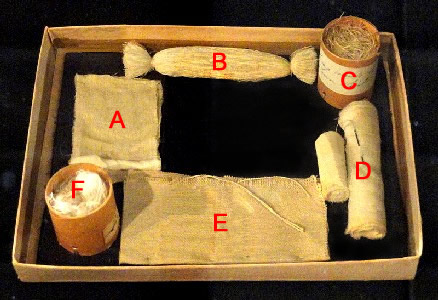
Photographer: Diderot
Civil War Era Bandages (very similar to 17th/18th centuries), from the Framingham
History Center in Massachusetts. Placard reads:
A -
Piece of Linen, Ready to be
Scraped; B - Drawn Lint; C - Fragments of Drawn
Lint;
D - Bandages;
E - Square of
Cloth,
Ready to be Drawn; F - Scraped Lint (Note - image from Dressings page.)
preparing for battle burns, military surgeon Raymund Minderer offers a list of suggestions to his readers.
You ought also to be provided with a fit apparatus, Lints, Swathing-clouts, &c. and to take Deer-suet, Oyl of Roses or Elder, and white Wax, and melt them more over the fire, yet so as that you melt the Wax, but it self, and add of it no more to the rest than to make it a thin plaister. Into this compound you mist dip some fine lint, and you'l find it very useful for any angry part...1
'Swathing clouts' would be pieces of soft linen. The rest of the ingredients would be used to treat the dressings in preparation for application. On the previous page in the section on saccharum saturni, there was a similar recommendation for prepared pieces of lint by sea-surgeon John Moyle, who called for "small Linteolas [small pieces of linen cloth]" coated with an unguent and "a large Sindon [medicated linen rag]" to apply the same.2
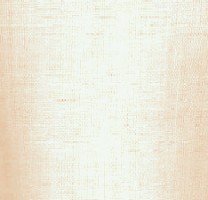
Linnen Lawn Cloth
Richard Wiseman is even more specific in his recommendation. For wounds that are raw, he "drest [them] with fine Lawn [a lightweight sheer linen]... and with a Feather dipt in unguent. de stramon. [thorn-apple unguent] mixt with ol. amygd. dulc. [oil of sweet almonds] anointed the Lawns: by which means those places which were superficially burned healed."3
William Fabry gives more detail on the desireability of soft dressings, explaining that "because Combustions [burns], especially those which are in the upper part of the skin flame with vehement sence, the Chirurgions ought to have a great care that they do gentle cleanse them; I, lest I should cause paine by cleansing Ulcers, doe cover the burnt part about with fine linen cloth, as with Cabricke [cambric] or Lawne, and I remove it not untill the Ulcer be whole, by this cloth the matter may easily flow forth, and the virtue of the Medicines may come unto the Ulcer"4.
Navy surgeon John Atkins specifies his dressings based on size. "Unless the Scald be of large Dimension, then indeed, for Convenience, I edge it only with Pledgets, and cover the middle Space with a Cerate [medicated wax-based solid] on Linnen; otherways those Edges drying irregularly, and without Digestion [building new tissue in the wound], would be apt to scab and inflame."5 It is interesting that Atkins worries about inflammation when supperation - the formation of 'laudable' pus - was an integral part of the healing of wounds by many period surgeons.
Several surgeons give advice on how to bind burns. Sea surgeon John Moyle warns that "in all
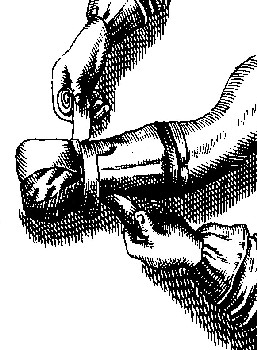
Bandaging an limb, from
The Chyrurgeons Storehouse, by
Johannes Scultetus, p. 44 (1653)
burns or Scalds; you must not bind on your dressings hard,
but only embrocate [moisten, with lotions], and spread on fine Linen, and apply it loosely."6 In another book he suggests that when a surgeon is dressing a burn ulcer, he "let things lye easie on, and when you anoint, let it be with a Feather."7 The feather was mentioned previously, but it, combined with the 'easie' dressing prove how concerned he was about the amount of pain created by overly-tight dressings. In a similar vein, William Fabry explains that for 3rd degree burns, after the blisters are cut to release the humors in them, doubled cloth dipped in medicine are "to be applied hot, for it easeth paine mollifieth and stayeth flux of humours."8
Along the same lines, John Atkins advises, "At the second dressing, I always use a warm Digestive [medicine to build tissue], thinner now while the Cuticle [burned skin] is on, to insinuate with the Muscosity of the Skin, and gradually blunt the fiery particles included: Rather with Pledgets of Tow [inexpensive linen cloth], then on Linnen, or Cerate-ways [rather than using regular linen or soft wax for the dressing], as softer and more alleviating, by not drying so fast"9.
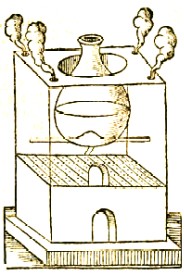
Artist: Thomas Hill (1594)
Distilling Colewort Water from
The Garder's Labyrinth, p. 12
Once the first dressings are medicated and put in place, Fabry recommends that "the affected part is to be rowled in rowlers modified in water and Vinegar, and if the offended part be the arme or the leg, begin at the infirme part, for by this meanes the humours are repressed, which are prepared to flow unto the hurt part"10. Where it isn't possible to use roller bandages, he advises the application of "linen clothes, madified [moistened] in water and vinegar 3 or 4 times a day, or also water wherein Colworts [wild cabbages] have bin infused (which should be of vinegar, water and salt) in which linen clothes be wet and applied, it doth mightily represse the Humours, easeth paine, and is an enemy to corrupt Humours"11.
Wiseman brings up some additional points regarding bandaging burns. First, he addresses the frequency of changing burn dressings noting that "[s]ome of the [burnt] Parts require to be drest twice aday; others but once."12
He also talks about the usefulness of bandaging in helping to prevent a problem particularly associated with some burns:
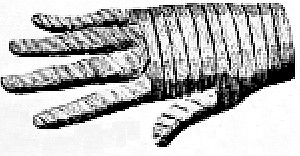
Hand Dressing Which Would Prevent Sydactyly
from Lorenz Heister's A General System of Surgery
By Bandage not only are Parts dexterously accommodated for Union [healing the skin]; but such also as would unnaturally grow together are kept asunder. In Burnings, Scaldings &c. the Fingers would many times grow together, the Chin would grow to the Breast, the Arms to the Sides, were they not this way hindred. But then are Fluxes averted and the delapse of Humours into the inferior Parts forbidden; and, being already lodged, they are prest out. By these are good Juices advantageously forced into Parts emaciated.13
It is interesting, although not really all that surprising, that this syndactyly - the growing together of burned body parts - is blamed on humors by Wiseman.
1 Raymund Minderer, A Body of Military Medicines Experimented, Volume 4 of Paul Barbette's, Thesaurus Chirurgiæ, The Fourth Edition, p. 113; 2 John Moyle, The Sea Chirurgeon, p. 97-8; 3 Richard Wiseman, Of Wounds, Severall Chirurgicall Treatises, p. 441-2; 4 Guliielm. Fabritius Hildanus aka William Fabry, His Experiments in Chyrurgerie, p. 30; 5 John Atkins, The Navy Surgeon, p. 176; 6 Moyle,p. 97-8; 7 John Moyle, Abstractum Chirurgæ Marinæ, p. 67; 8 Hildanus, p. 33; 9 Atkins, p. 176; 10 Hildanus, p. 29; 11 Hildanus, ibid.; 12 Wiseman, p. 442; 13 Wiseman, p. 343
Burn Treatment - Surgical Debridement
Debridement is the process of removing dead skin so that the wound beneath it can heal. It is practised today when tissue is burned badly enough the the skin is dead and has no chance of recovering.
Richard Wiseman explains that when burns "go deeper into the Skin it causes an Eschar [area of dead tissue]: If a burn deeper into the Flesh, the force of the fire makes a hard Crust with a Contraction. In all these the Pain is excessive."1 Wiseman advised that when a patient's skin is "burnt with Gun-powder, they must pick out the Powder first; else they will carry the same blew Mark... which I have often been imployed
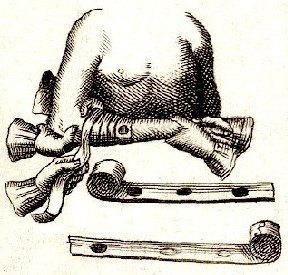
An Arm Dressing from Johannes Scultetus'
L'Arcenal de chirurgery, p. 68, Table27
to take out... but could never remove them otherwise than by taking off the Skin."2 However, Wiseman stops short of recommending the dead skin be removed heroically by the knife in normal burns, explaining instead that where the skin is "burnt to a Crust or Eschar, you must hasten its fall with Emollients [softening medicines], then digest [use medicines to encourage the formation of new tissue], incarne [build tissue], and cicatrize [heal them over with a scar]."3
Sea surgeon John Atkins reommends that the dead skin must be removed, but not with the surgeon's blade. He advises the his reader to "let the succeeding Dressings hereafter mentioned, strip off the Cuticle, [remove the burnt, dead skin on the surface] as the less painful Way [than forcibly removing the dead skin]; for by its laying flat, and hindring the Access of Air, Cold, and the immediate Applications [of medicines]; the nervous Papillæ are better defended, and consequently the Pain mitigated, which it will be subject to, in a more extraordinary Degree till Maturation succeeds; which begins in a dressing or two, and then [the dead skin] separates every Day."4
So, with the exception of Wiseman's suggestion that the skin be removed to avoid tattoing of the skin with the marks of the gunpowder,
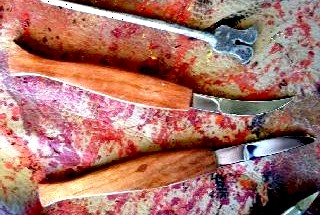
Photo: Rosabella
A Scalpel Guide, Bistoury Knife and Scalpel
most of our period surgeons don't suggest heroic debridement. The consensous seems to be to let medicines soften the dead skin, allowing it to be taken away with the bandages.
The lone dissenter is William Fabry who explains that "wheresoever the upper skin is separated, let it be peeled off, lest matter should gather together under it"5. Fabry, being a strong proponent of the humoral theory, goes on to indicate that such a place would be a gathering point for 'bad' humors and removing the skin would prevent this. He explains the process when describing treatment for third degree burns.
the Escarre is to be separated, or at least to be cut away almost as close as the flesh, whereby the humour which is retained under the hard crust may flow forth, the Medicines may enter, and whatsoever is inducerated and hardned by reason of the heat may softened; the Escarre ought to be separated the first or second day before the part be inflamed"6
As the other surgeons have suggested, it would also be an incredibly painful way to debride - pulling the skin away would seem to be more painful (in part because it would be slower) than removing it with a scalpel.
1 Richard Wiseman, Of Wounds, Severall Chirurgicall Treatises, p. 440; 2 Wiseman, ibid.; 3 Wiseman, p. 441; 4 John Atkins, The Navy Surgeon, p. 176; 5 Guliielm. Fabritius Hildanus aka William Fabry, His Experiments in Chyrurgerie, p. 27; 6 Hildanus, p. 32
Burn Treatment - Burn Blister Treatment
Blisters are a natural part of
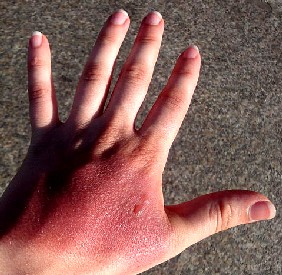
Photo: Vera de Kok - Blistering from a Scald Burn
burns, raised by the body as a protective measure. However, nearly all the golden age of piracy era doctors recommend cutting them open to allow the wound to heal. Sea surgeon John Moyle recommended that "as Blisters arise, cut them; that the hot scalding water may not Ulcerate Deeper."1 Fellow sea surgeon John Atkins recommends opening them as well, suggesting that the blisters that arise soon after burning be "snip[ped] at present to let out all the acidulating Serum... Should you keep the Vesiculæ uncut, retaining the extravasated Serum, you run the hazard of deep stinking Ulcers, and a more unseemly Cicatrix [scar]."2 In a case study, Richard Wiseman explains how he snipped the blisters "lest by their erosion they make hollow Ulcers, and inflame with sharp Pains, Fever, &c."3
Snipping with scissors seems to be the preferred method of opening blisters. William Fabry explains that the first step in dealing with 2nd degree burns is to "let the blisters be all cut with cizors whereby the hot and sharpe water may flow forth", going on to indicate that this will help prevent the formation of bad "humours and bloud [which] doe presently flow to the affected place"4. He likewise suggests this as the initial action in third degree burns with the flowing serum from the snipped blisters "to be dryed with a clout or sponge"5.
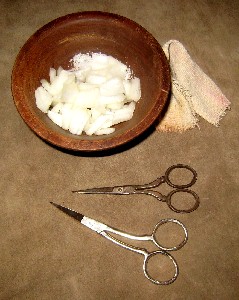
Period Tools For Blister Treatement -
Onion and Salt Mixture and Small Scissors
The concern about the formation of humors permeates Fabry's discussion of blister treatment. Elsewhere, he notes that "many humours do concurre together unto the offended part, which do putrifie and get a kind of a sharpe and knowing quality, so that they doe deeply crode the skin and flesh, and do cause a rotten ulcer and naughty Scar: Therefore the pustels are presently to be cut, that the sharp and hot water may flow forth."6
Fabry suggests that the onion and salt mixture discussed previously in the section on medicines be used to prevent blisters. His advises that "if pustels be not risen, let the corrupt and sharpe humours be drawn forth with an Ointment made of Onions and the like"7. Wiseman, while not specifically detailing that an onion/salt mixture will prevent blisters does explain that "the common remedy is, to apply Salt and an Onion beaten together. But this is not to be done after the Blisters are risen, nor by any means where the Part is raw; for so you will exasperate the Pain, and increase the Inflammation."8
Today, the purpose of blisters is better understood, humor theory has been disproven and so cutting them open is not recommended. As emergency room director Dr. Brenda Reilly explains, "blisters provide a natural barrier to infection. They are your body's very own sterile bandages. The tissue under a blister is sensitive and, like most open wounds, is vulnerable to bacteria and viruses. If you open or drain a burn blister, you could slow the healing process, cause harmful scarring or invite infection."9 It is curious that the period surgeons were defeating the very thing they were trying to accomplish by opening the blisters, but medicine was still in its infancy at that time.
2 John Moyle, The Sea Chirurgeon, p. 97; 2 John Atkins, The Navy Surgeon, p. 176; 3 Richard Wiseman, Of Wounds, Severall Chirurgicall Treatises, p. 441; 4 Guliielm. Fabritius Hildanus aka William Fabry, His Experiments in Chyrurgerie, p. 27; 5 Hildanus, p. 32; 6 Hildanus, p. 9; 7 Hildanus, p. 19; 8 Wiseman, ibid; 9 Dr. Brenda Reilly, " Healthy Outlook: Blisters are Nature's Band-Aid for Burns", Contra Costa Health Services, published January 23, 2013, gathered from the Internet on 7/8/13

